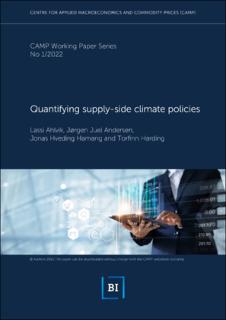| dc.contributor.author | Ahlvik, Lassi | |
| dc.contributor.author | Andersen, Jørgen Juel | |
| dc.contributor.author | Hamang, Jonas Hveding | |
| dc.contributor.author | Harding, Torfinn | |
| dc.date.accessioned | 2022-03-06T19:05:14Z | |
| dc.date.available | 2022-03-06T19:05:14Z | |
| dc.date.issued | 2022-02 | |
| dc.identifier.issn | 1892-2198 | |
| dc.identifier.uri | https://hdl.handle.net/11250/2983258 | |
| dc.description.abstract | What are the effects of supply-side climate policies? We use global firm-level data to estimate the impact of 130 oil-tax reforms between 2000 and 2019 on oil production, exploration and discoveries. Higher taxes are found to reduce firms’ exploration expenditures and oil discoveries. We quantify the oil market implications and show that the existing production-based taxes, averaging at 21%, reduce the long-term emissions by 1.3-2.7 GtCO2 annually.
Increasing the global tax rate would reduce emissions almost linearly, by 0.16 GtCO2 per percentage point, while further shifting the distribution of rents from consumers to producers and governments. | en_US |
| dc.language.iso | eng | en_US |
| dc.relation.ispartofseries | CAMP Working Paper Series;01/2022 | |
| dc.subject | oil taxation | en_US |
| dc.subject | climate change | en_US |
| dc.subject | supply-side climate policies | en_US |
| dc.title | Quantifying supply-side climate policies | en_US |
| dc.type | Working paper | en_US |
| dc.source.pagenumber | 42 | en_US |
